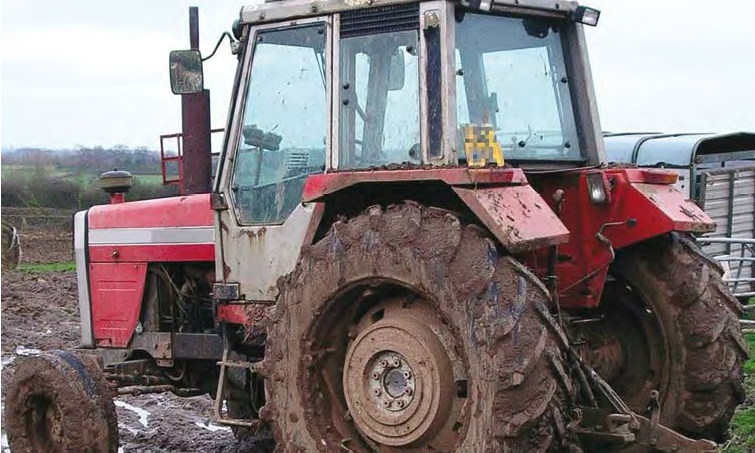Criminals Cultivating New Tactics in Rural Crime
At the beginning of March this year, Jamie Smart, chair of the NFU Scotland legal and technical committee asserted that rural crime was on the rise; illustrated through recent figures from NFU Mutual which estimate that rural crime costs those who live and work in the countryside almost £2 million each year[1]. Across the UK, high value tractors worth around £80k have been targeted as well as lower value tractors with low-tech security systems. Livestock theft has also increased by 25%, making 2013 one of the worst years on record for livestock theft with Northern Ireland the worst affected area of the UK. James Kelly, Chief Executive of the British Security Industry Association (BSIA) discusses.
Statistics also reveal that of all UK counties, Cambridgeshire bore the greatest cost from rural crime at £2.7m last year. Northern Ireland and the East Midlands saw the largest year-on-year increase (38% and 15% respectively). As well as tractors and livestock thefts, the other most commonly targeted items were fuel, tools and quad bikes, with the cost of quad bike theft rising by 14%.
Plant machinery is vulnerable as it is often left alone for longer periods of time, not to mention the common single-key operating system on a lot of older vehicles that can make them easier to start up and drive away. Plant theft is also a largely international crime, with organised criminals often stealing the goods and transporting them to international destinations within a matter of days, making them much harder to track and retrieve.
To make matters worse, other types of opportunist crimes – such as the theft of tools and ornaments – are also on the rise; meaning efficient security is of the utmost importance to the rural community. Rural crime cost the UK £44.5m last year, with all corners of the UK affected across all sectors of the agricultural industry. This means that although plant machinery is still a top priority on the rural community’s list of security concerns, criminals are consistently finding new targets in order to generate profit.
With this in mind, what can the rural community do to protect their businesses?
 There is a wide range of security products and services on the market that can help tackle the various problems, therefore, it can be beneficial to take a holistic approach to security, considering a number of different integrated methods rather than just a couple.
There is a wide range of security products and services on the market that can help tackle the various problems, therefore, it can be beneficial to take a holistic approach to security, considering a number of different integrated methods rather than just a couple.
Physical security measures – such as gates, fences and locks – are often the first barrier of defence so it is critical that they are regularly maintained to work to their optimum potential. As the backbone of security, they should also be the best possible measures that the business can afford, for example investing in electronic security measures. As part of a layered approach to security, physical security measures can provide the essential layer of protection that can help prevent crime all together, or at the very least give personnel ample time in order to react accordingly to a potential threat.
Overt obstructions such as security fences, gates, or security-wire products can discourage criminals from even attempting to breach the security, eliminating the risk immediately. Similarly, having a human presence is very effective. With well-trained manned guarding patrolling the perimeter, intruders are often immediately discouraged.
Perimeter protection should be linked to security further inside property boundaries, such as an intruder alarm or CCTV cameras, allowing for careful observation of the perimeter around the clock. CCTV cameras are very effective, especially when integrated with other systems. For example, using CCTV in conjunction with Automatic Number Plate Recognition (ANPR) software allows for the identification of vehicles moving in and out of a site. Should an intruder take or damage property, ANPR can provide the police with valuable information to track down suspects.
CCTV systems and detectors positioned around the perimeter can be linked to a Remote Video Response Centre (RVRC), so should an intruder set a detector of, an operator at the RVRC will be able to decide the best course of action. This can be as simple as issuing a verbal warning over the system, which scares off intruders and prevents them from entering the premises further or depending on the threat, alert the authorities without the intruder realising they have been detected.
For some, covert perimeter protection is a more desirable choice. Some intruders may be able to break through covert perimeter protection, and as it is more obvious, figure out ways to defeat them over time. With concealed forms of perimeter protection, intruders are not aware that they have been spotted.
Particularly effective forms of covert security are heat and motion sensors that are hidden and connected to alarm systems. Known as Unattended Ground Systems (UGS) they enable an early warning system, giving personnel time to respond effectively.
 Perimeter-specific applications of Video Content Analysis (VCA) – the automatic analysis of CCTV images in camera or centrally – such as the tripwire function, can be very effective. VCA is also utilised to create virtual tripwires along existing boundaries where other forms of physical security would be impractical. If a person is simply walking nearby, they are not considered a threat therefore a great amount of attention doesn’t need to be paid to them. However, if that person then crosses the tripwire into a secure area, an alert is raised. The VCA draws attention to the cause of the alarm, allowing the operator to quickly assess the severity of the alarm. VCA is more resistant to false alarms caused by vegetation or animals and lower false alarm rates improve security.
Perimeter-specific applications of Video Content Analysis (VCA) – the automatic analysis of CCTV images in camera or centrally – such as the tripwire function, can be very effective. VCA is also utilised to create virtual tripwires along existing boundaries where other forms of physical security would be impractical. If a person is simply walking nearby, they are not considered a threat therefore a great amount of attention doesn’t need to be paid to them. However, if that person then crosses the tripwire into a secure area, an alert is raised. The VCA draws attention to the cause of the alarm, allowing the operator to quickly assess the severity of the alarm. VCA is more resistant to false alarms caused by vegetation or animals and lower false alarm rates improve security.
The most essential part of choosing any security solution is that you purchase from a trusted supplier who meets the relevant British and European standards in regards to their equipment. BSIA members are all inspected to these high quality standards and can offer you a reputable service. To find a suppler near you, visit http://www.bsia.co.uk/company-finder.
[1] The Scottish Farmer: http://www.thescottishfarmer.co.uk/news/rural-crime-in-the-spotlight.26542434



